You constantly hear gardeners saying that you should deadhead your roses. But what does that really mean? And how do you do it? And for that matter, when should you break out the pruners?
I can relate. When I first started growing roses, I felt totally overwhelmed. They seem like such complicated, needy plants. If I deadheaded them wrong, I feared that I might ruin everything.
Fortunately, deadheading isn’t all that difficult. But it’s essential if you want to encourage your plants to bloom all season long.
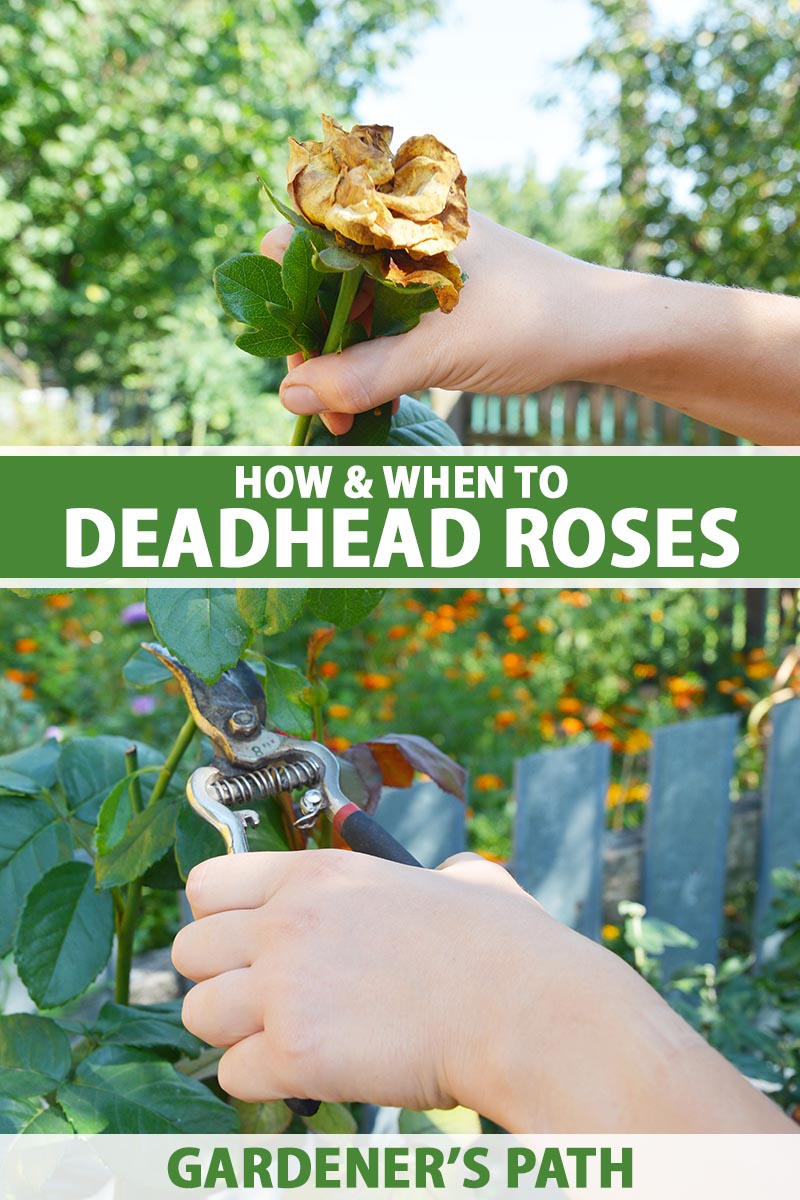
We link to vendors to help you find relevant products. If you buy from one of our links, we may earn a commission.
If you let a blossom stay until it turns brown and forms a hip, the plant often thinks it’s time to start putting its energy into developing seeds so it can reproduce.
That’s usually not what we want. We want more flowers!
This guide will transform you into a deadheading master. Here’s what we’ll go over:
What You’ll Learn
Sharpen and sanitize your secateurs, because we’re going in.
What Is Deadheading?
Okay, first things first. What is deadheading, exactly?
Well, deadheading is the act of removing a flower that is nearly spent, and it’s usually done in order to encourage more blossoms. At the same time, it enables you to improve the shape of the plant so it doesn’t look straggly.
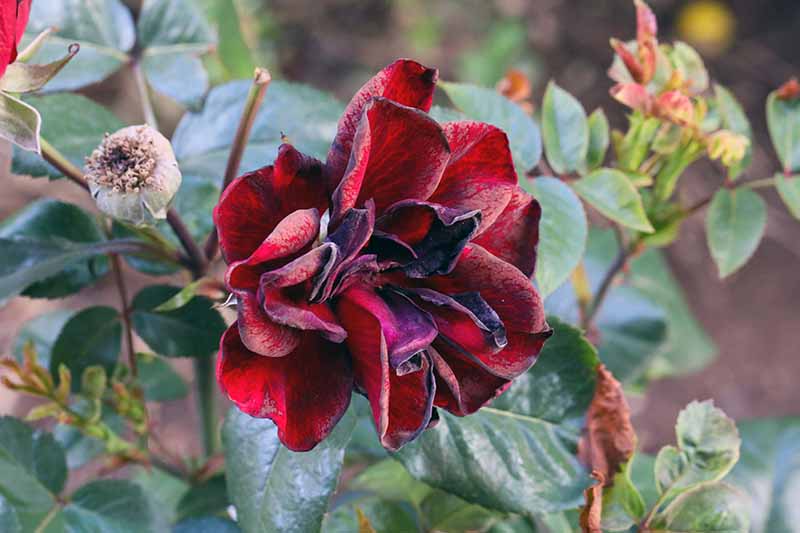
When a blossom is left in place, the plant usually starts putting its energy towards creating hips (fruit containing seeds) so that it can reproduce. When seeds start forming, the rose plant releases a hormone that tells it to stop blooming for now.
On top of that, a spent blossom tends to look unkempt, and if it rains or the sprinklers hit it, the blossom turns into a mushy mess. This can encourage fungal diseases.
Keep in mind that deadheading isn’t the same thing as pruning. You aren’t trying to create a different shape for your plant or removing diseased bits. This is just about encouraging new flowers to form.
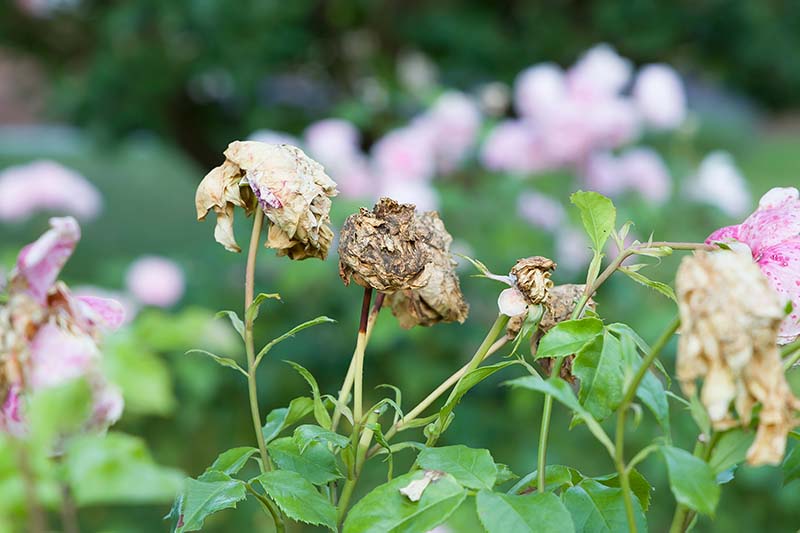
Also note that not all roses need deadheading. Self-cleaning roses shed their blossoms on their own and will continue blooming without extra encouragement.
Popular Knock Out® roses will rebloom whether you deadhead or not.
Even so, they will still look tidier if you remove the spent blossoms. You might want to spruce your plant up a little, even if it is self-cleaning. To do this, just snip the spent flower heads with a pair of clean secateurs.
As a quick added note, self-cleaning roses are infertile so they don’t create hips. If you want hips, don’t select one of these.
When to Clip Spent Blooms
You should deadhead continuously through the entire blooming season, which may vary according to the specific species, hybrid, or cultivar.
When the roses are in bloom, deadheading is a part of my daily routine to help make it an easier task. If you leave it to every week or so, it takes longer each time, and you will end up leaving blossoms on the plant for too long.

When I grab my coffee in the morning to drink on the patio outside, I also grab my clippers and do a quick once-over of my rose plants. I remove any flowers with petals that are starting to droop or turn brown.
The point is that deadheading is much easier if you do it every day, or at least every few days. If you let the job build up, it’s going to take a while and you’re probably going to miss a few blooms, which means your plant might blossom less.
Better to make it a regular habit! If you drink coffee on the patio in the morning like I do, bring your clippers too. If you take the dog out in the evening, bring the clippers. (Are you sensing a pattern here?)
Put your clippers or scissors somewhere convenient where you’ll remember them and make this a habit. Always remember to clean them between uses as well.
The easiest way to determine which roses need to be removed is to just gently shake the plant (watch for thorns – aka prickles!).
Any blossom that drops petals is done. Snip it. Flowers that are drooping or turning brown should also be removed.
Stop deadheading in the fall. Once Labor Day rolls around, put down the secateurs and take a well-deserved break.
How to Deadhead
Sure, you can just head out and clip or twist off any flower that you see that doesn’t look like it’s in its prime. But there’s a better way.
Every rose has leaves that grow in groupings of one, three, five, or more leaflets.
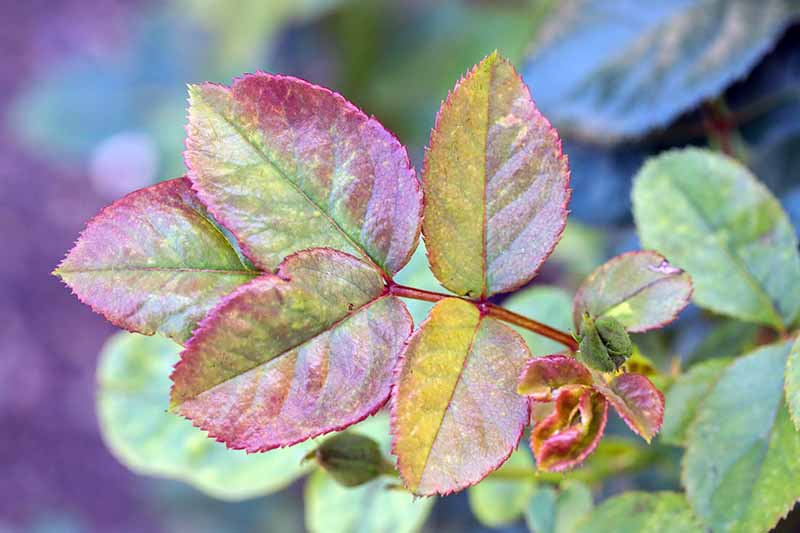
The best place to deadhead is above the first leaflet that has five leaves on it. That means you should make a cut right above that five-leaf leaflet.
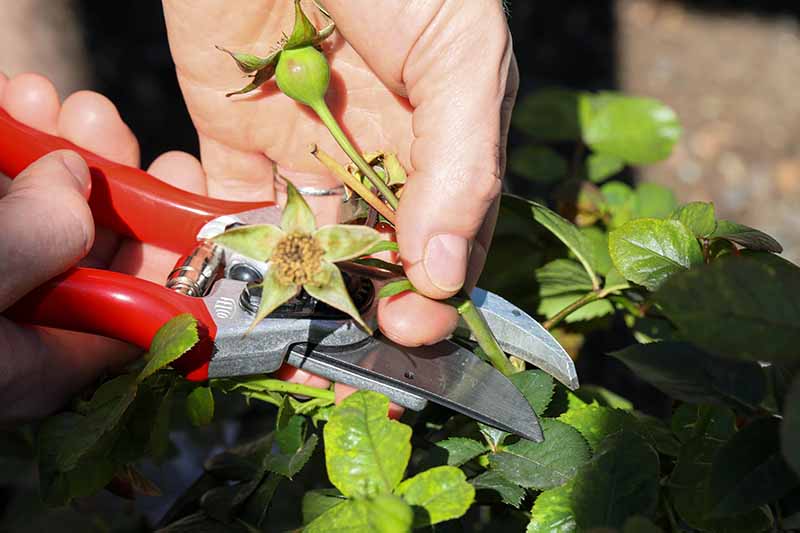
Make the cut with a clean pair of clippers at a slight angle about a quarter of an inch above the leaflet.
Don’t snip the stem in the middle, between a leaflet and the flower. Not only does this not look good, as it fails to foster compact growth, it might also prevent that stem from blooming again this season. Make your cuts near the leaflet.
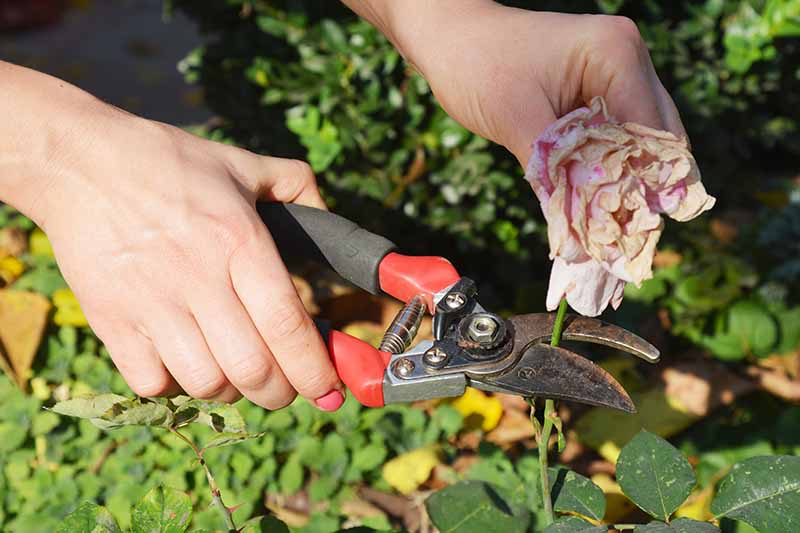
Some people suggest that you make each cut at an outward-facing leaf bud for a more appealing look, but it doesn’t seem to make a difference to me.
The only exception to the five-leaf leaflet rule is after the first bloom of the season. In that case, you should trim back to the first leaflet that has three leaves instead.
Why? Younger canes aren’t as thick as older canes, so early-season growth should be deadheaded a little differently. The goal is to cut the cane (sometimes called a stem) back to the point where the cane is still strong, but not too old to produce healthy growth.
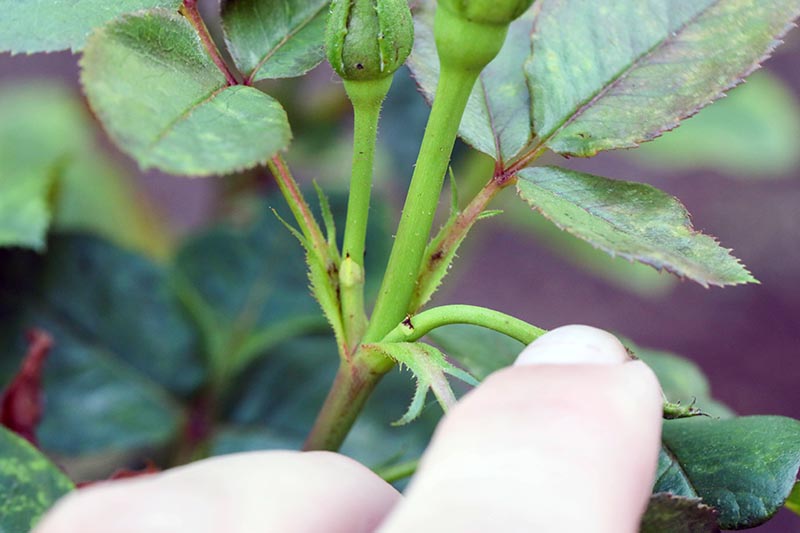
If you are deadheading a rose that grows blossoms in clusters, just snip away the single rose that you’re after as close to the joint as possible.
Once all of the flowers in that cluster are spent, cut back to the first five-leaf leaflet.
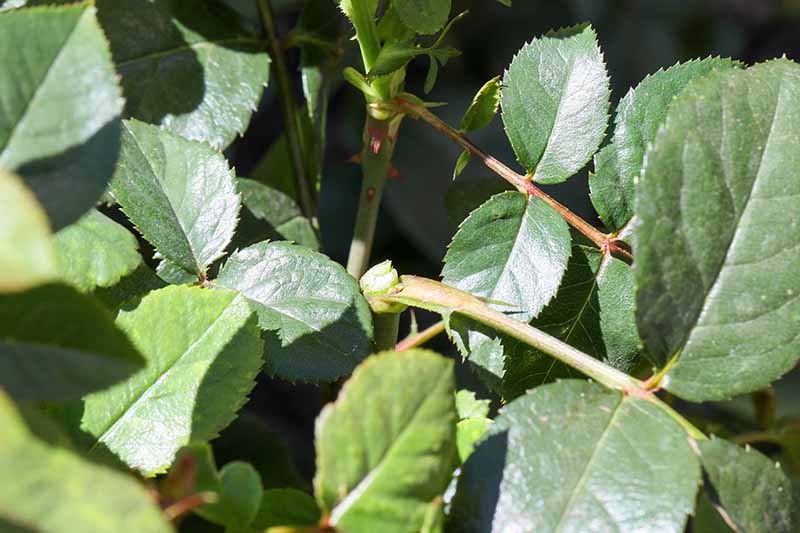
For wild roses that bloom in masses, just treat each branch as one giant rose, even though it is actually made up of up to a dozen or so flowers. Trim back to the first five-leaf leaflet when a majority of the flowers look spent.
Always make sure that you clean your clippers in a solution of one part bleach to ten parts water in between plants. I know this seems like a lot of work, but it will save you a lot of trouble down the road because it helps to prevent the spread of disease.
By the way, if you’re curious about which kind of clippers to use, any pair will do. Even scissors work.
But lots of pros swear by Felco F-2 secateurs. They don’t have any extra bells and whistles like rotating handles or thick padding, but they are well-made, make precision cuts, keep your hand in a comfortable position, and will last you a lifetime.
That’s what we use at the Portland International Rose Test Garden.

If you want to pick up a pair for your garden kit, head on over to Amazon.
If you want a lot of blossoms, you need to leave as much of the foliage in place as possible.
Foliage helps the plant to produce flowers by storing and manufacturing food, moving water, and exchanging oxygen and carbon dioxide. On top of that, the foliage provides shade to the canes and roots of the plant.
All of this is essential to your plant’s health. And a healthy plant produces more flowers.
I once had a neighbor who would deadhead by taking his electric hedge trimmers and buzzing the plant back until there were no blossoms left. It was certainly quick, but imprecise.
He was removing foliage that the plant needed to be healthy, and leaving stems in place that would have been better to remove (not to mention removing flowers that were ready to bloom).
Don’t pinch or snap off the flowers. Use your clippers.
A quick note: sometimes buds won’t open if the weather is too wet and cool. This is called balling. Gardeners can also induce this problem by watering roses on the foliage rather than at the soil level.
Regardless of how it happens, prune any of these unopened blossoms back to the first leaflet with five leaves to help prevent disease (and general ugliness).
You’re Ready to Deadhead Like a Pro
There you have it! All the info you need to make your rose plants look absolutely fantastic.
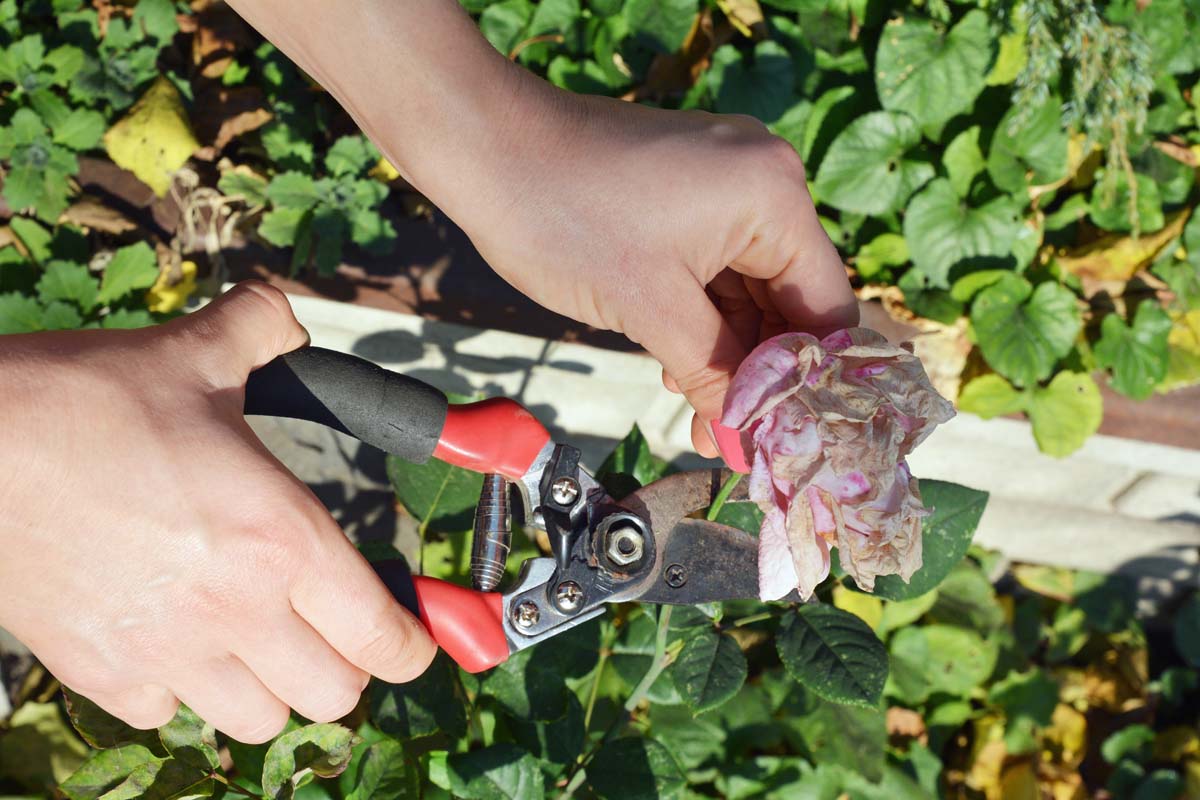
Now, instead of feeling overwhelmed, hopefully you feel empowered to head outside with your clippers and wrestle your roses into shape.
If so, come back and let us know in the comments section below what kind of roses you’re growing and how the deadheading is going.
Then, you might want to take a look at some of our other useful rose guides next:


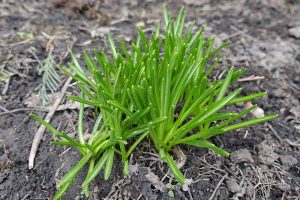
I have a number of hybrid teas that don’t present a 5 leaf leaflet until you get 6 to 10 inches down the cane. There are mostly 3 leaf leaflets near the top, so deadheading down to the first 5 leaf leaflet causes the stem or cane to not produce a bud for as many as 6 weeks. What do you think? Deadheading at the 3 leaf leaflet seems to be just as fine, but many people still say to head for the 5. Thank you and I’ve enjoyed your articles!
Just deadhead to the nearest three-leaf leaflet. Some roses, especially hybrid teas, are just weird like that. Cutting back to the five-leaf is ideal, but it won’t hurt the plant to go to three instead. Sometimes we just have to adapt! Do cut back to the five-leaf leaflet for your final deadheading at the end of the season.